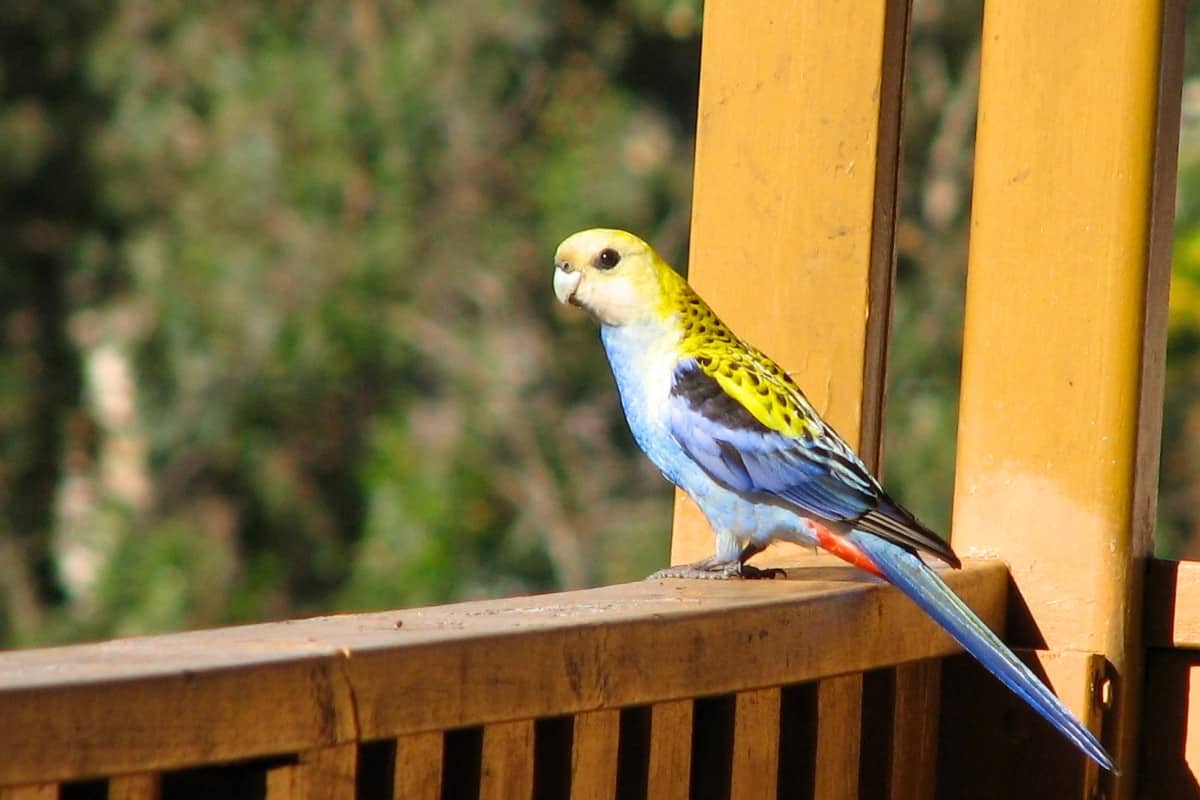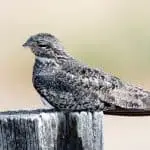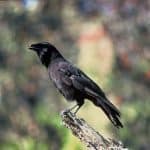Pale-headed rosella resting | image by Paul Gear via Wikimedia Commons | CC BY-SA 3.0
Common Name: Pale-headed Rosella
Scientific Name: (Platycercus adscitus)| Size | Diet | Range in Hawaii | Status in Hawaii |
|---|---|---|---|
| 12 in. | seeds, fruits, berries, and blossoms | Unknown | Least Concern |
The Pale-headed Rosella (Platycercus Adscitus) is a beautiful and colorful parrot species that is native to Australia. With its striking blue and yellow plumage and playful behavior, this bird is a beloved sight in its natural habitat.
However, the species was once established as a naturalized (non-native) resident in Hawaii, where it was introduced in the early 1900s. Unfortunately, the Pale-headed Rosella is now considered extirpated in Hawaii, meaning it is no longer present in the state.
In this article, we’ll explore the fascinating world of the Pale-headed Rosella, its unique adaptations, and its behavior in the wild.
Pale-headed Rosella
Appearance
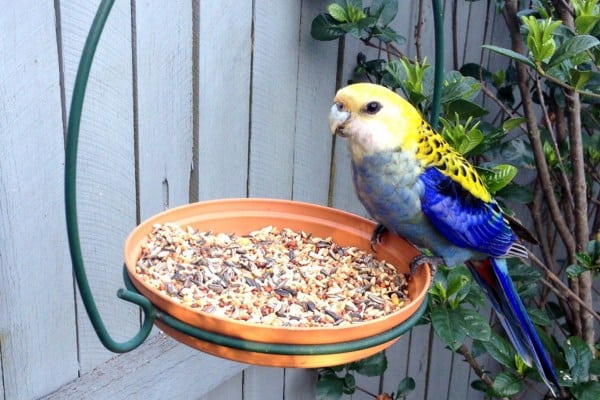
The Pale-headed Rosella is a visually striking parrot species known for its captivating appearance. Measuring approximately 12 inches in length, this bird showcases a beautiful combination of colors.
Its most prominent feature is its pale blue head, which contrasts brilliantly against its vivid red breast. The rest of its body is adorned with a vibrant mix of green and yellow feathers, creating a dazzling display of hues.
Diet
These parrots have an omnivorous diet, meaning they consume a variety of foods. Their primary diet consists of seeds, fruits, berries, and blossoms found in their natural habitat. They are also known to feed on nectar, pollen, and even insect larvae.
Nesting
The Pale-headed Rosellas construct their nests in tree hollows, taking advantage of natural cavities or old woodpecker holes. The female takes the lead in nest building, using leaves, twigs, and bark to create a cozy and secure nest chamber within the hollow. Once the nest is ready, the female lays a clutch of eggs, usually around 4-6 in number.
Both the male and female take turns incubating the eggs, ensuring their warmth and safety. After an incubation period of around 19-21 days, the eggs hatch, and the parents diligently care for their chicks.
They provide them with regurgitated food, ensuring their nourishment and growth. As the chicks develop, their downy feathers gradually transform into the vibrant plumage characteristic of adult Pale-headed Rosellas.
Behavior
These parrots are highly social and often seen in small flocks, engaging in various activities that showcase their intelligence and adaptability. With their agile flight, they gracefully maneuver through the trees and sky, emitting distinctive calls that add a touch of charm to their presence.
One notable behavior of Pale-headed Rosellas is their acrobatic feeding style. They can be seen hanging upside down from branches, skillfully plucking fruits, seeds, and blossoms. Their dexterity and flexibility are truly remarkable, allowing them to access food sources that may be otherwise challenging to reach.
These birds also display strong pair-bonding behavior. Mated pairs engage in mutual grooming, reinforcing their bond and strengthening their relationship. During courtship displays, they perform graceful aerial acrobatics and exchange food as a symbol of affection.
While Pale-headed Rosellas are generally peaceful, they can become vocal and territorial during breeding season, defending their nesting sites from intruders. Their sharp calls and vibrant plumage serve as warnings and displays of aggression when necessary.
Habitat
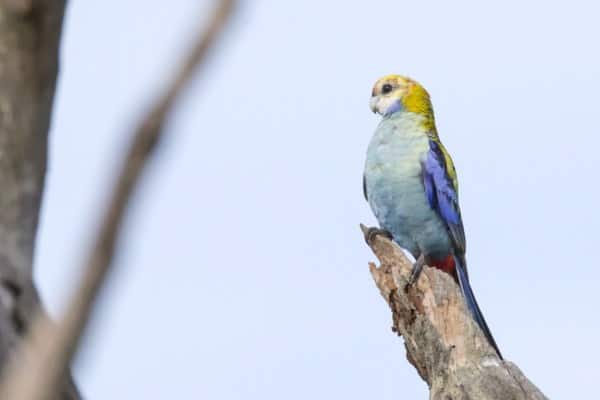
The Pale-headed Rosella is adaptable and can be found in a variety of habitats. In Eeastern Australia, they inhabit woodlands and open forests, often near water sources and at higher altitude forests in the Southeastern Hawaiian Islands.
Range
The Pale-headed Rosella originally from eastern Australia, established a population on Maui in the Southeastern Hawaiian Islands for over 50 years. However, it is now believed to be extinct on the island and in Hawaii as a whole. Introduced in the late 1800s, the species disappeared from sightings, likely due to agricultural control measures.
Conservation Status
However, despite its visual splendor, the pale-headed rosella faces significant challenges when it comes to its conservation status. Currently, this beautiful bird is listed as a species of “Least Concern” on the IUCN Red List. While this classification may seem positive at first glance, it is crucial to understand the underlying factors affecting its population.
Interesting Facts
1. Nesting communalities
In some instances, pale-headed rosellas may engage in a unique nesting behavior called “communal nesting.” Multiple breeding pairs may share the same tree hollow, creating a cooperative nesting arrangement. This communal nesting strategy allows for enhanced protection against predators and social interactions among the individuals.
2. Hybridization
In areas where their ranges overlap, pale-headed rosellas have been known to hybridize with other closely related parrot species, such as the eastern rosella (Platycercus eximius). These hybrid offspring may display intermediate coloration and a mix of traits inherited from both parent species.
3. Bathing rituals
Like many parrot species, pale-headed rosellas enjoy bathing. They take frequent dips in water sources, such as puddles or shallow streams, to clean their feathers and maintain their plumage’s health and appearance.
4. Avian intelligence
Pale-headed rosellas are known for their intelligence and problem-solving abilities. They have demonstrated excellent problem-solving skills in laboratory settings, such as using tools to obtain food rewards or navigating complex puzzles. Their cognitive abilities contribute to their adaptability and survival in changing environments.
5. Cultural significance
Pale-headed rosellas hold cultural significance among the Aboriginal people of Australia. They are revered as spiritual symbols and feature prominently in indigenous art and stories, representing aspects of nature, beauty, and connection to the land.
Frequently Asked Questions
1. Are pale-headed rosellas good as pets?
Pale-headed rosellas can be kept as pets, but they require proper care and attention. They are intelligent and social birds that need mental stimulation, regular exercise, and a spacious enclosure. It’s important to research their specific needs and provide them with a suitable environment.
2. Can pale-headed rosellas talk or mimic sounds like some other parrot species?
While pale-headed rosellas are not known for their extensive mimicry abilities, some individuals may imitate certain sounds from their environment, including other bird calls and human noises. However, their vocalizations primarily consist of various chirps, squawks, and melodic calls.
3. What is the lifespan of a pale-headed rosella in captivity?
When provided with proper care and a suitable environment, pale-headed rosellas can live for around 15 to 25 years or more in captivity. A balanced diet, regular veterinary care, and a stimulating living environment contribute to their longevity.
4. How can I attract pale-headed rosellas to my garden?
To attract pale-headed rosellas to your garden, you can provide suitable food sources such as native fruits, seeds, and nectar-producing plants. Installing bird feeders or offering fresh water can also attract them, along with providing nesting boxes or suitable roosting sites.
